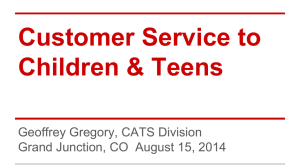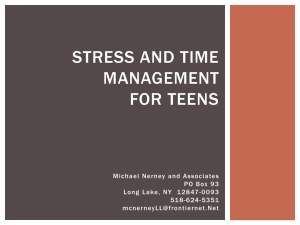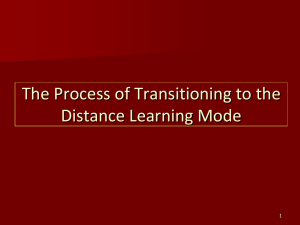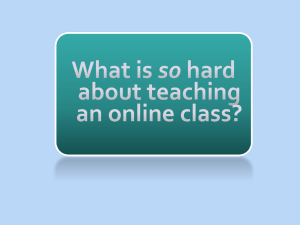Levy Presentation - University at Buffalo
advertisement
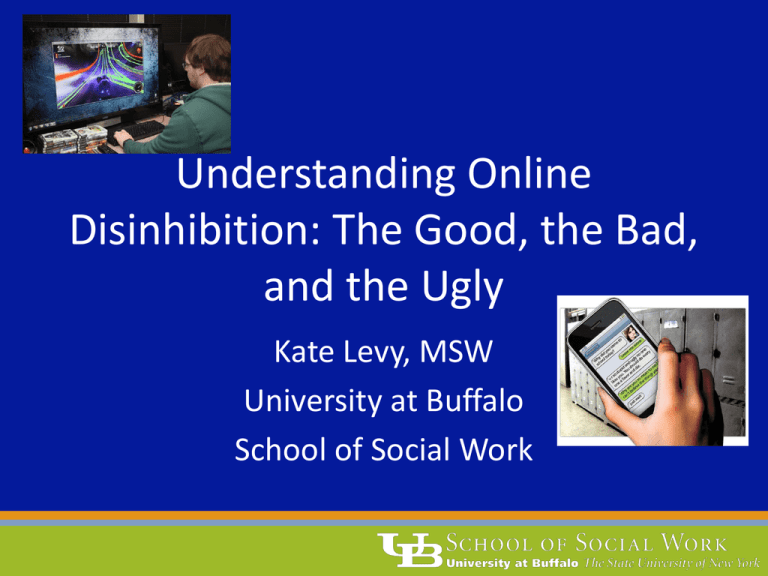
Understanding Online Disinhibition: The Good, the Bad, and the Ugly Kate Levy, MSW University at Buffalo School of Social Work Objectives • Provide an in-depth examination of the online disinhibition effect and each of its components • Identify who and how individuals are affected by online disinhibition • Explore the potential benefits of online disinhibition • Articulate the role of online disinhibition in cyberbullying and other negative online interactions • Explore the potential repercussions of prolonged online disinhibition in face-to-face interactions • Recommendations • Questions/Answers What is Online Disinhibition? • Every person behaves differently in virtual spaces than they would in face-to-face interactions – We loosen up – We become less restrained – We tend to express ourselves more openly • This phenomenon is known as online disinhibition (Suler, 2004) Dissociative Anonymity “Who am I?” • What can people really tell about us on in virtual interactions? • In virtual interactions, we can hide some or all of our identity- creating a separation between our in-person and virtual identity • My virtual behaviors aren’t really me Invisibility “You can’t see me.” • In virtual interactions, we cannot always be sure where/when someone is present • Virtual invisibility gives us the courage to do things that we perhaps would not do otherwise • Physical invisibility also means less inhibited expressions Asynchronicity The “emotional hit and run” (K. Munro, unpublished observations, 2003) • Virtual communications are asynchronousinteractions do not always happen in real time • Not immediately coping with a person’s reaction disinhibits • There is safety when posting something personal, emotional, or hostile and then “running away” Solipsistic Introjection “It’s all in my head.” • When we don’t know what a virtual person looks/sounds like, we tend to assign traits to those individuals • Interactions with this introjected character feel more imaginary • We also may treat a virtual companion as ourselves, which can lead to greater disinhibition Dissociative Imagination “It’s all a game.” • The virtual world is in a different space entirely, with imaginary characters completely separate from the real world • Virtual life can then be viewed more as a game versus as a real world interaction • How we act in “fantasy games” is not always how we act in the real world Minimized Authority “We are all equals here.” • In the real world, authority and status are expressed by clothing, body language, etc. – We are stripped of these markers in virtual interactions • We are more willing to speak out and misbehave without possible disapproval and punishment from authority figures Personality • Not every person will be disinhibited in the same way or to the same level in virtual interactions • Individuals can be predisposed to being more disinhibited based on personality • The intensity of a person’s underlying feelings, needs, drives, etc. affects susceptibility to online disinhibition as well Benign Disinhibition • Not all disinhibition is a bad thing • Disinhibition can be a very cathartic experience • We can be extremely generous and kind to others in the virtual world – Ex. Donating to causes via GoFundMe.com Benign Disinhibition • Combat loneliness and depression through online social interactions (Morahan-Martin & Schumacher, 2003) • Moderate negative moods through online social interactions (Morahan-Martin & Schumacher, 2003) Benign Disinhibition • Using the internet to find satisfying relationships to provide emotional support (Valkenburg & Peter, 2011; Morahan-Martin & Schumacher, 2003) • Individuals with low self-esteem are more comfortable with online interactions (Joinson, 2004) – Online disinhibition can also enhance self-esteem and self-confidence (Valkenburg & Peter, 2011) Benign Disinhibition and Virtual Gaming • Multiplayer online role-playing games allow for positive disinhibition that allows for longterm social relationships (Cole & Griffiths, 2007) • Virtual gaming allows players to express themselves differently than in real life due to appearance, gender, sexuality, age, etc. Toxic Disinhibition • Disinhibition can be UGLY- this is the disinhibition we think of more often • Rude language, harsh criticisms, anger, hatred, threats, etc. are all toxic disinhibition • Toxic disinhibition also causes individuals to occupy virtual spaces that they would not explore otherwise Cyberbullying • “Willful and repeated harm inflicted through the use of computers, cell phones, and other electronic devices” (Hinduja & Patchin, 2011) – Harassing, threatening, humiliating, hassling, etc. their peers – Spreading rumors – Creating web pages, videos, and fake social network profiles to make fun of others – Taking photos and videos of others where privacy is expected and distributing them online Cyberbullying and Toxic Disinhibition • Less public evaluation leads to less remorse (Mason, 2008) • No direct social disapproval (Willard, 2007) • Do not need to see the victim physically suffer (Willard, 2007) Can Online Disinhibition Affect Face-to-Face Interactions? • Online usage by children and adolescents (ages 1217) (Pew Research, 2014) • 95% of teens have access to the internet • 74% have mobile access to the internet • In 2012, 81% of online teens use some kind of social media Teen Device Ownership (Pew Research, 2014) • In 2012, 78% of online teens owned a cell phone – 30% of teens owned a smartphone – This is nearly doubled since 2004 • 8 out of 10 teens own a desktop or laptop computer • 23% of teens have a tablet computer Teen Device Usage (Pew Research, 2014) • 50% send 50 or more text messages a day • 67% surveyed teens said they were more likely to use their cell phone to text friends rather than calling or talking face-to-face • 54% said that they text their friends once a day, but only 33% said they talk to their friends face-to-face on a daily basis • American between the ages of 8 and 18 spend on average 7.5 hours per day using some sort of electronic device Can Online Disinhibition Affect Face-to-Face Interactions? Does this look familiar? Can Online Disinhibition Affect Face-to-Face Interactions? • The development of a child’s social aspects can be greatly impacted due to an insufficient amount of real life social encounters (Diaz, Evans, & Gallagher, 2014) – It is easy and more convenient than real life encounters • Fiscal expressions, body language, eye contact, and conversation skills suffer because of this • Further, the social skills learned through online disinhibition may bleed into face-to-face interactions – This is due to a lack of learned empathy Managing Online Disinhibition • Don’t post or send anything you would be embarrassed for certain others to see • Do be careful about over-sharing • Don’t hang out with the “wrong crowd” online • Don’t hang out with the “wrong crowd” offline • Do consider your emotional state before virtually posting or responding to anything • Do consider the reaction individuals are expecting from toxic disinhibition • Do search for yourself online Questions/Answers Contact Information Kate Levy, MSW 685 Baldy Hall Buffalo, NY 14260 716.523.0065 klevy2@buffalo.edu



